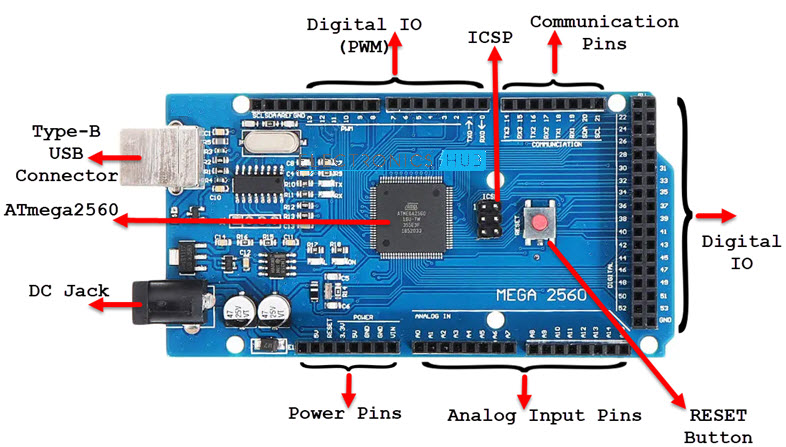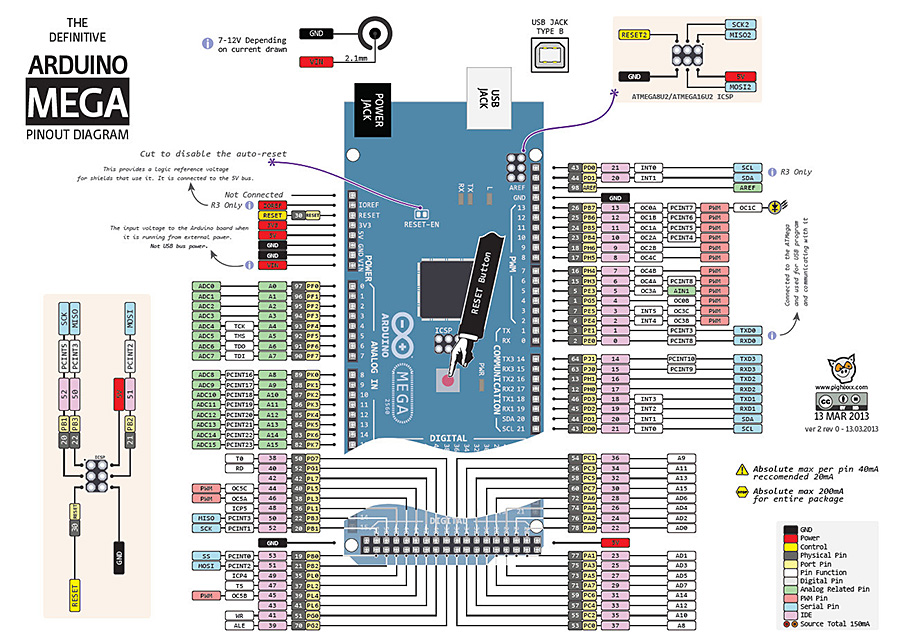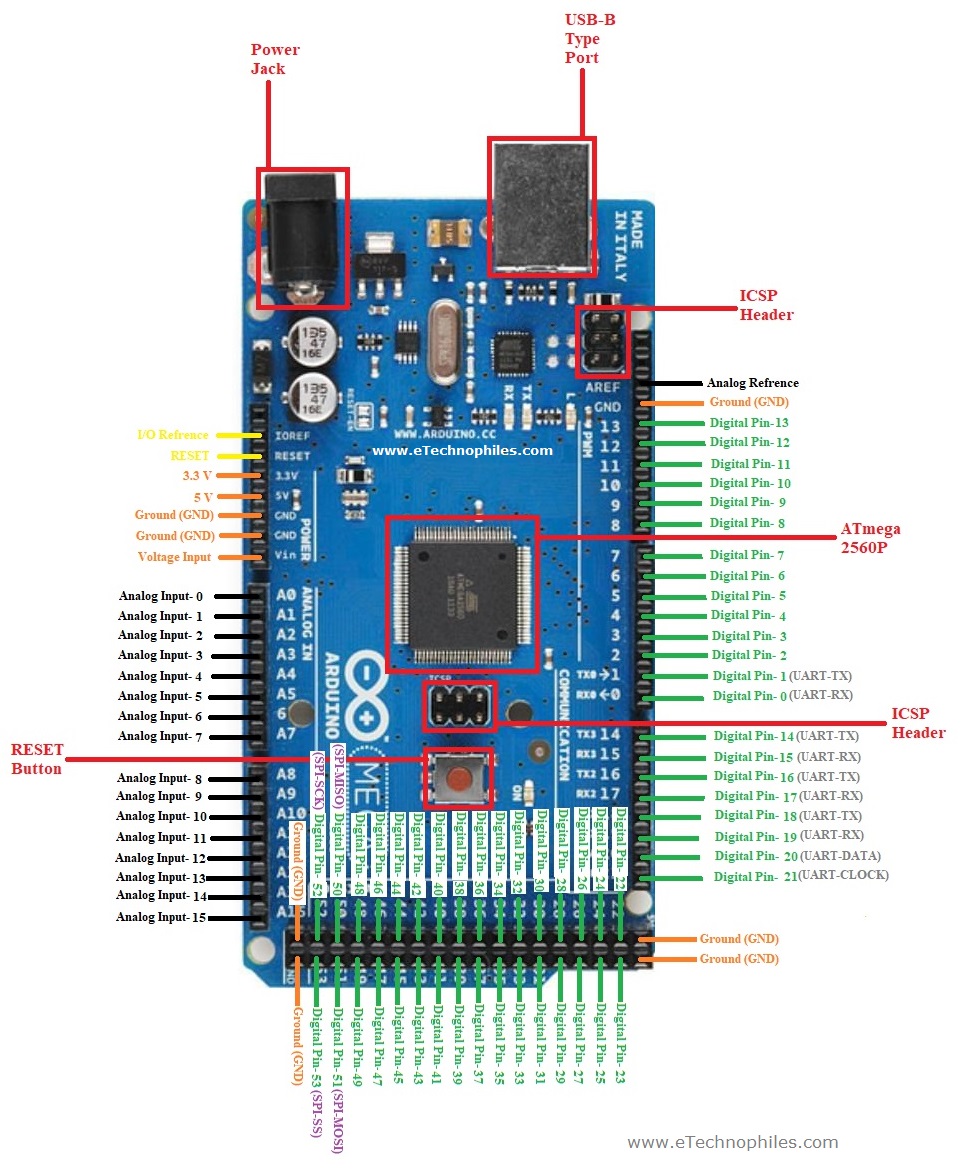

- #ARDUINO MEGA PINOUT SHEET BLANK HOW TO#
- #ARDUINO MEGA PINOUT SHEET BLANK SERIAL#
- #ARDUINO MEGA PINOUT SHEET BLANK CODE#
Apart from that, the layout of Arduino Mega is very much self-explanatory. There is also a 2.1 mm DC jack to provide external power supply. Layout of Arduino Mega BoardĪs you can notice, there is a Type-B USB connector on the left short edge of the board, which is used for powering on the board as well as programming the Microcontroller. Unlike Arduino Nano, all the components are placed on the top side of the PCB. The following image shows the layout of a typical Arduino Mega board. So, if you are developing some advanced robotic projects or 3D Printing hardware and want to use the Arduino environment, then Arduino Mega 2560 is the board for you. It is designed and developed to provide more number of IO lines (both Digital and Analog), more flash memory and more RAM when compared to UNO. It is available in a 100-pin Quad Flat Package. It can be considered as a big brother to both UNO and Nano, both in terms of size as well as features.Īrduino Mega is based on ATmega2560 Microcontroller, an 8-bit AVR Architecture based MCU from ATMEL.

While Arduino Nano is a breadboard friendly version of Arduino UNO with more or less the same features, Arduino Mega is completely a different board. The answer to this is the Arduino Mega Board. Since the introduction of Arduino UNO as a quick prototyping board, there has always been a demand for more features than what Arduino UNO can offer.
#ARDUINO MEGA PINOUT SHEET BLANK SERIAL#
Serial.begin(9600) // open serial connection Mfrc522.PCD_Init() // Initialize Proximity Coupling Device (PCD) MFRC522 mfrc522(pinSDA, pinRST) // Set up mfrc522 on the Arduino Such an mechanism can be used to identify users, when each user owns a different RFID tag. In each iteration, a single byte is read and printed out as hexadecimal value (00.FF). In the following code, a for-loop is used to iterate through the tag. The second function reads the RFID tag id. Luckily, the library offers two very handy convenience functions for reading tags: The first functions allows to detect whether an RFID tag/card is present. In order to get the RFID reader running, you have to setup the library itself, a SPI connection, as well as the reader. If you cannot find such an entry, I recommend to visit the official website of the library for further assistance. Then, search for “RFID” and you will find an entry with the title “MFRC522 by GithubCommunity”. If you are using the Arduino IDE, the library can be easily installed by clicking “Sketch->Include Library->Manage Libraries”.
#ARDUINO MEGA PINOUT SHEET BLANK CODE#
The code makes use of an existing RFID library which can be found here. have different recommended pin layouts!): The complete pin layout is shown by the following table ( works only for the Arduino Uno! Mega, Nano etc. The module might get damaged, if it is accidentally connected to the Arduino’s 5V pin. Therefore, the module’s 3.3V pin must be connected to the Arduino’s 3.3V. In the following, the pin layout is shown as recommended by the documentation of the MFRC522 library (used later in the programming section). The RFID-RC522 module comes with eight pins (of which seven pins are used in this tutorial).

#ARDUINO MEGA PINOUT SHEET BLANK HOW TO#
How to connect the RFID-RC522 to the Arduino? Schematic of how to connect the RFID-RC522 to the Arduino.

In order to demonstrate the RFID-RC522 module, a simple application is programmed which identifies a user based on an RFID tag. The RFID-RC522 module reads only High frequency tags at 13.56 MHz. In order to read an RFID tag, the reader and the tag must have the same frequency. The RFID-RC522 module is an RFID reader, which can read RFID tags in close-range. In this tutorial, it is shown how to use the RFID-RC522 module with the Arduino Uno. RFID stands for Radio-frequency identification and can be used for many application that require an identification mechanism. Setup of this tutorial: RFID reader and two RFID tags.


 0 kommentar(er)
0 kommentar(er)
